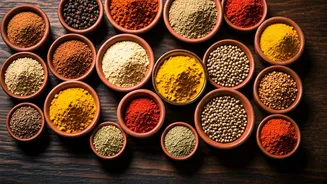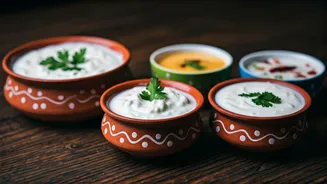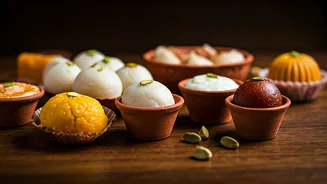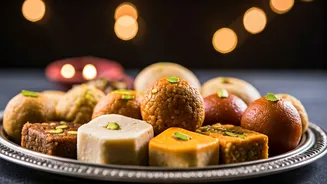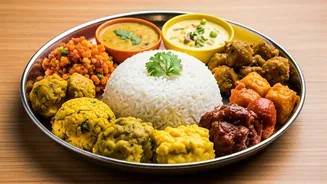Spice Route Unveiled
Indian cuisine, a culinary tapestry woven with threads of history and geography, owes its distinctive character to the strategic location along ancient
trade routes. These paths facilitated an exchange not only of goods but also of ideas, cultures, and most significantly, spices. The availability and use of various spices were not just about taste enhancement; they were integral to preservation, medicinal practices, and cultural rituals. Consider turmeric, celebrated for its vibrant hue and health benefits, or cardamom, known for its aromatic properties that infuse both sweet and savory dishes. The complexity of Indian cuisine lies in the artful blending of these spices, each playing a crucial role in creating the layered flavor profiles that define regional variations. From the fiery chilies of Andhra Pradesh to the delicate saffron of Kashmir, spices dictate the essence of each dish, creating a culinary heritage that is both diverse and deeply rooted in tradition.
Northern Culinary Delights
The northern regions of India, encompassing states like Punjab, Uttar Pradesh, and Kashmir, boast a rich culinary heritage, often influenced by the Mughal empire. Meat-centric dishes, such as the creamy butter chicken and the savory rogan josh (lamb in a flavorful gravy), are prominent. These dishes showcase the use of slow-cooking methods and rich ingredients like cream, yogurt, and nuts, creating textures that are both comforting and decadent. The bread is a cornerstone of northern meals, with various types such as naan (leavened flatbread baked in a tandoor), roti (unleavened flatbread), and paratha (layered flatbread) providing the perfect accompaniment to the curries and kebabs. The tandoor, a cylindrical clay oven, is a key element in northern cooking, imparting a smoky flavor to both meats and breads. Furthermore, the influence of Persian and Central Asian flavors is evident in the liberal use of dried fruits, nuts, and aromatic spices such as cardamom, cinnamon, and cloves, adding depth and complexity to the dishes.
Southern Flavors Explored
The cuisine of South India, including states like Tamil Nadu, Kerala, and Karnataka, is characterized by its use of rice as a staple, along with coconut, lentils, and a vibrant array of spices. The dishes are often lighter and tangier than those of the North, owing to the use of tamarind, tomatoes, and coconut milk. Dosa (fermented crepe made from rice and lentils) and idli (steamed rice cakes) are iconic breakfast foods, often served with sambar (lentil-based vegetable stew) and coconut chutney. Seafood plays a significant role in coastal regions, with dishes such as fish curry and prawn fry being extremely popular. The use of curry leaves and mustard seeds is widespread, contributing to the distinct aroma and flavor profiles of South Indian cooking. The cuisine also reflects the region's diverse cultural influences, blending vegetarian and non-vegetarian options. The emphasis is on fresh ingredients, balanced flavors, and a focus on using spices for their unique aromas and digestive properties, offering a lighter and flavorful taste.
Western Culinary Traditions
Western India, particularly the states of Maharashtra, Gujarat, and Goa, presents a fascinating blend of flavors and culinary styles. Mumbai, a melting pot of cultures, offers a wide range of street food, including vada pav (potato patty in a bun) and pav bhaji (vegetable curry served with bread). Gujarati cuisine is predominantly vegetarian, emphasizing sweet, sour, and spicy tastes. Dhokla (steamed lentil and rice cakes) and undhiyu (mixed vegetable casserole) are popular dishes, often sweetened with jaggery and spiced with a variety of aromatics. Goan cuisine, on the other hand, reflects Portuguese influences, with dishes such as vindaloo (pork in a fiery vinegar-based sauce) and xacuti (chicken or meat curry with coconut and spices) showcasing a distinct blend of Indian and European flavors. The use of coconut, seafood, and a mix of chili peppers and spices is prominent, offering a unique and exciting culinary experience. The dishes are characterized by a focus on bold flavors, fresh ingredients, and a touch of the exotic.
Eastern Culinary Landscape
Eastern India, encompassing regions like West Bengal, Bihar, and Odisha, is known for its sweet dishes and distinctive use of mustard oil. The influence of the Bengali cuisine is seen in the use of fish, rice, and lentils, with dishes such as maachher jhol (fish curry) and kosha mangsho (slow-cooked mutton curry) being particularly popular. Sweets play a significant role in Bengali culture, with delicacies like rasgulla (spongy cheese balls in syrup) and mishti doi (sweet yogurt) being loved. Bihari cuisine also emphasizes vegetarian dishes, with litti chokha (baked wheat balls with roasted vegetable mash) being a famous comfort food. In Odisha, seafood and rice form the core of the cuisine, with dishes reflecting a blend of coastal and inland flavors. The use of spices is moderate, with dishes often incorporating ingredients like turmeric, ginger, and green chilies to create balanced flavors. Eastern India's cuisine, therefore, stands out for its delicate balance of sweetness, tanginess, and spices, as well as its focus on rice and fish, delivering a culinary experience that is unique and full of character.
Vegetarian Dishes Abound
Indian cuisine is celebrated for its rich variety of vegetarian dishes, catering to a large vegetarian population. Lentils (dal) are a staple, cooked in various ways with different spices, resulting in a wide array of flavors. Paneer (Indian cheese) is used in numerous dishes, such as palak paneer (cheese with spinach) and paneer butter masala (cheese in a creamy tomato sauce). Vegetables, cooked with a range of spices and often served with roti or rice, are a common part of meals. From the creamy korma to the spicy vindaloo, and the fresh vegetable curries, vegetarian options offer a broad spectrum of tastes and textures. The use of spices like turmeric, cumin, coriander, and garam masala elevates the flavor of these vegetarian dishes, making them a feast for the senses. Vegetarianism in Indian cuisine is not merely about excluding meat; it's about celebrating the flavors and textures of plant-based foods, transforming simple ingredients into memorable and satisfying meals. This emphasis on vegetarian cuisine showcases the country's deep-rooted respect for nature and health, making it a cornerstone of Indian cooking.
Spices: The Essence
Spices are the heart of Indian cooking, infusing dishes with their unique flavors, colors, and aromas. From the warm, earthy notes of cumin and coriander to the vibrant heat of chili peppers and the fragrant aroma of cardamom and cinnamon, spices play a vital role. They are not merely flavor enhancers but are also valued for their medicinal properties and digestive benefits. The art of blending spices is a crucial skill, with chefs and home cooks carefully combining different ingredients to create complex and balanced flavor profiles. Masala, a mixture of spices, is a fundamental component of many Indian dishes, with each region having its unique blends. The use of freshly ground spices is prized, as they deliver the most potent and fragrant taste. The correct proportions and cooking methods are essential to draw out the flavors of the spices, ensuring that each dish is a harmonious blend of tastes and aromas. The richness and complexity of Indian cuisine, therefore, is fundamentally dependent on the careful and respectful use of spices, transforming simple ingredients into extraordinary culinary creations.
